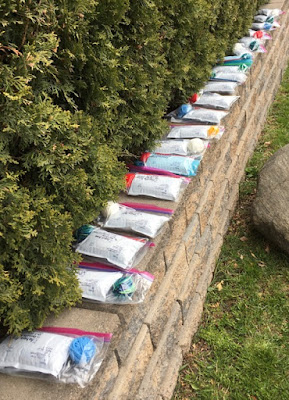
Happy Mother's Day to all the Room 222 families!
Today is Day 56 of our stay-at-home time. Keep reading to see a recipe for a chocolate dessert for a special occasion and an example of a "cycle" research project.
CHOCOLATE DIPPED TREATS
Looking for a fast and easy dessert to make for Mother's Day?
Here is a recipe for chocolate dipped treats.

 You will need:
You will need:
1 cup (250 mL) chocolate chips
orange segments, almonds, rice cakes ( You can use whatever you like...)
What to do:
* Cover a plate or pan with aluminum foil, (so the chocolate will not stick).
* Make sure the plate or pan will fit in the fridge.
* Put the chocolate chips in a heat proof bowl. (I used a glass cup measure.)
* Melt the chips in the microwave oven at half or 50 % power for 30 seconds.
* Stir the chips with a spoon and keep heating the chocolate 30 seconds (half power) at a time, stirring after each time, until it is almost all melted. (I repeated the heat-stir pattern four times, but your microwave may need more or less time.)
* Take out the bowl and stir the chocolate until it is all melted and smooth.
Start dipping the treats:
* For orange segments, I dipped half in the chocolate and put the pieces on the foil covered plate.
* For almonds, I put the almonds in a small bowl and poured some of the melted chocolate on top and mixed it with a spoon to coat them. Then I used a spoon and dropped groups of 5 almonds on the foil covered plate.
* For the rice cakes, I crumbled the rice cakes in a bowl and poured melted chocolate on top. I mixed it to coat the pieces with chocolate. I put it on the foil and shaped the "blob" into a rectangle (which I cut into slices later).
* For the writing, I poured the melted chocolate into a small ziplock bag, sealed the bag and cut one of the corners off with a pair of scissors. Using the bag I squeezed the chocolate out over the foil wrapped plate and wrote the word "Mom" in cursive.
* Using the bag of chocolate, squeeze out "doodles" on the foil.
* PUT THE PLATE IN THE FRIDGE for the chocolate to harden.
* Peel the treats off the foil and arrange on a plate just before serving. ENJOY!
NOTES - You could also dip many other things: strawberries, pretzels, marshmallows and really whatever you like!
 SAMPLE RESEARCH PROJECT
SAMPLE RESEARCH PROJECT
Today I posted an assignment on Google Classroom for you to research a plant, tree, animal or earth cycle. I chose to research yeast because I have a yeast "sourdough starter" at home and I want to learn more about yeast. This is my "sourdough starter" that I have at home. My friend Jennie gave it to me. I have to feed it flour and water every week to keep it alive. The yeast eats sugar and makes carbon dioxide gas (CO
2). That is why the picture on the right has more because it has more bubbles. The bubbles you see in bread come from the gas made by yeast.
What cycle did you choose to learn more about?
I chose the life cycle of yeast.
Who discovered it?
Louis Pasteur, a French scientist, discovered how yeast works.
It's Latin or science name is Saccharomyces cerevisiae which means "sugar eating fungus".
When was it discovered?
It's been used for thousands of years but in 1859 (161 years ago) Louis Pasteur discovered that yeast was what made bread rise.
Where do you find it?
Yeast is found everywhere on Earth, even at the North Pole!
Why is it important to Earth?
Yeast is used in making foods like bread, soy sauce and vinegar. It also helps you digest food.
It is used to make medicines like insulin.
How long is the life cycle or how long does the cycle last?
As long as yeast has sugar to eat it can live for years.
Cool fact #1
Yeast is not an animal and is not a plant. It has only one cell. (Humans have 100 trillion cells!)
Cool fact #2
Each yeast is sphere or oval shaped and is smaller than 10 micrometers wide. (A micrometer is one millionth of a metre.)


















































